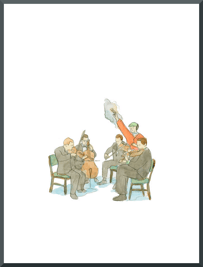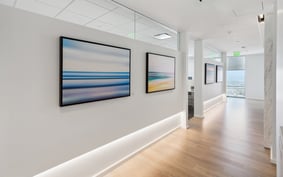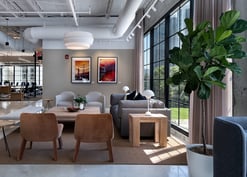Get Art For Your Business For Free!!!
If your office needs artwork, there’s no doubt that headline grabbed your attention, and understandably so. Your first follow up question is probably along the lines of “How is that even possible?” Well, the answer revolves around a phrase that is sure to make most artists roll their eyes in frustration: “alternative gallery space.” Meaning, turn your office walls into a space for artists to show and sell their work.
At first, it might sound like a win-win; there are seemingly low upfront costs to the company, and it appears like a gesture of goodwill to the local art community. However, like any good click bait headline, the snappy sell of free art masks some rather disappointing realities.
Undertaking an office gallery project is a lot more work than most companies anticipate, and without a team member fully devoted to the project, there’s a lot to go wrong. The design, scope of the gallery area, and curation are inevitably going to vary from space to space, but there remains a number of fundamental tasks that cannot be avoided.
First, the staff member or team running the project must decide if they will feature a particular artist, or a group of artists, whether they’ll conceive a concept or theme for the exhibit, and how long it will run before turnover. Ideally, they will have a personal network to reach out to, but if not, they must do the time-consuming work of tapping into extended networks, local art groups, and posting open calls through art forums to find interested and local artists. Invariably, with no promise (or even likelihood) of compensation, the project manager will be dealing with a lot of nos, and letting down a lot of eager-but-not-quite-right-for-the-space yeses.
Once they’ve finally secured a satisfactory number of vetted artists, the project manager must tackle both the hard logistics and soft nuances of curation. They must coordinate with the artist(s) to determine factors such as piece selection, price and payment structure in the event of a sale, artwork insurance and, in some cases, agreement terms and contracts, before transitioning into the on-site tasks of wall space availability and layout, artwork transportation, installation, rotation, and display of artist marketing materials.
There’s no such thing as a free lunch
Anyone who’s taken an Economics 101 course has probably heard an instructor sing this adage at one point or another. And though the phrase might be hackneyed, the principle is essential in the case of office gallery spaces, as more often than not, the decision is made in the interest of saving the company money. However, the opportunity costs incurred by choosing the gallery model arguably outweigh the actual dollar cost of a hired artwork solution.
The hidden costs
Starting with the most direct of all, there is the cost of the employee’s time. Every minute an employee spends making outreach calls to artists, sifting through inbound applications, planning exhibit concepts and schedules, drafting contracts, getting insurance policies, and coordinating layouts and installations, could be spent on other, more essential tasks for the business. From curation to installation, a gallery program can take months, and most significantly, installation hardly marks the the end of the project.

Since this model asks artists to lend artwork for no guaranteed compensation, they are entitled to take their artwork from the office at anytime (with little to no warning) to show in a professional gallery or to sell to a private or corporate buyer, and the better the artwork, the more likely it is to occur. At that point, the project manager has an empty hook on the wall, and must scramble to find a replacement. In the event that the artist is able to bring another one of their pieces as a replacement, the likelihood of it being a similar size, style and color scheme is slim. The more artists featured in the exhibit, the more frequently that scenario will take place, leaving the project manager to juggle schedules, office drop-ins, and carrying out the task of redecorating. To prevent this, some companies will require artists to sign contracts stipulating exclusivity, but as a result, they encounter even more challenges in getting artists to sign on, and drastically narrow the scope of the artwork’s quality.
Less straightforward, but just as critical, is the cost to the company’s brand. Nowadays, office environments are expected to embody the organization’s culture and values, and artwork is one of the most dynamic and effectual means of doing so. However, in alternative gallery models where the exhibitors are uncompensated, the vast majority of artwork will come from amateurs and hobbyists. Due to the narrowed selection, the project manager is backed into curating with an “I’ll take what I can get” mentality, rather than judiciously selecting works attuned to the greater vision of the space. Additionally, a disjointed collection of paintings with price tags, hanging above a display of artist marketing materials lacks professionalism, and diminishes the impact of more thoughtful (and costly) design and decor choices made throughout the office space.
A bad deal for artists
While some companies may adopt the gallery program based on line items alone, many also have the well-intentioned desire to get involved in the art community, and give support to artists. This is a misconception.
For an artist to show their work in an office’s gallery, they must donate time, money, and assets to a project with inherent risk for an unlikely payoff. In most cases, once the artist and project manager have determined the piece specifics, it is left up to the artists to frame, transport, and install their works at the office. In an effort to avoid the complications associated with piece removal and swapping, some companies will elect to require artists to sign contracts committing exclusivity, precluding them from participating in events that provide more viable sale opportunities, and in turn, negating support for their success.
To understand office gallery programs better from an artist’s perspective, I spoke to Boston TurningArtist, Regina Valluzzi. Regina has participated in a number of alternative gallery programs throughout her career, but she’s still waiting on her first sale. What is more, Regina calculates that once framing treatments, marketing materials, placards, and hardware are paid for, she’s fronted about $200 out of pocket just to get the pieces on the wall, and is frequently left with the decision of either leaving them uninsured, or incurring the additional costs of insurance per piece.

When considering this against Regina’s success on TurningArt, which includes three original sales and over a dozen print sales, as well as her success in traditional gallery settings and through various art walks and pop-up shops, the basis of the alternative gallery model as an act of artist support proves shaky.
It’s failure is caused, in part, by unavoidable logistical realities, as offices spaces are generally not suitable for hosting art exhibits in crucial ways, from their display and layout, to their restricted audiences, access, and hours of operation. But, more significantly, the failure is caused by the disconnect between context and purpose. While the artist incurs upfront costs of their time, money, and assets in the interest of a potential sale, artwork sales are not the focus of the office manager’s job, and office employees are not in the office to purchase artwork. Regina cited her major points of frustration as revolving around this disconnect, along with disorganized or uninvolved points of contact at the offices, who don’t have the time to devote to promoting artwork sales, and frequently “disappearing” marketing material displays that inhibit the ability to connect with any potentially interested buyers.
How about an affordable lunch instead?
So the office gallery model doesn’t deliver on the low-cost promise to the company, or the goodwill gesture to the artist. Does that mean we have to dial it all the way back to the more traditional and expensive model of purchasing through consultants and galleries? Of course not, and that’s where we come in. TurningArt is designed to offer an affordable artwork leasing service, while simultaneously providing direct compensation to living, working artists. For the price of a single original piece, companies can outfit their entire office with a thoughtful, tailored collection from our catalog of over 15,000 prints. If you don’t want to take my word for it, take Regina’s, whose very first remark when asked about her experience with alternative gallery spaces was “For me, the TurningArt rental model has worked far better than hanging work for free for 'the exposure.' ”
To learn more about what TurningArt can do for your company, get in touch with us here.
And if you’d like to learn more about the impact of artwork on company culture and employee productivity, take a look at our eBook below:


.jpg?width=332&height=177&name=_MG_0840%20copy%20(2).jpg)

.jpg?width=332&height=177&name=dtBv_067_DSC_2139_DaNil%20(2).jpg)

.jpg?width=332&height=177&name=TurningArt_EnerNoc_2-18-2014-3_Final%20(1).jpg)

